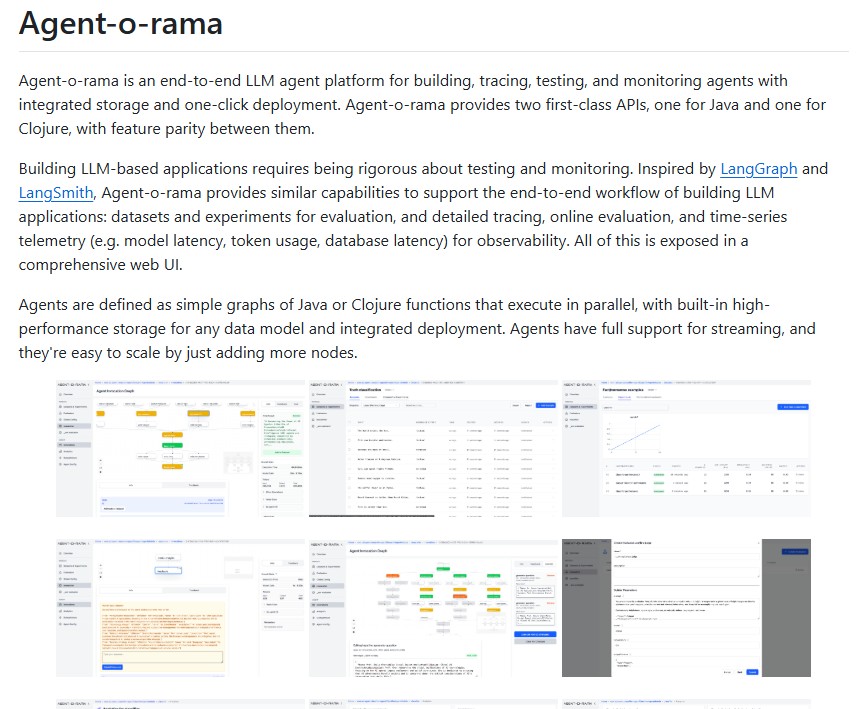As large language models (LLMs) become more capable, developers are increasingly using them to build intelligent AI agents that can perform reasoning, automation and decision-making tasks. However, building and managing these agents at scale is far from simple. Challenges such as monitoring model behavior, debugging reasoning paths, testing reliability and tracking performance metrics can make the process complex and time-consuming.
This is where Agent-o-rama, developed by Red Planet Labs, steps in. Agent-o-rama is a comprehensive platform for building, tracing, testing and monitoring LLM agents with integrated data storage and one-click deployment. Designed for Java and Clojure developers, this open-source framework simplifies the full lifecycle of agent-based application development from experimentation to production.

Inspired by leading frameworks such as LangGraph and LangSmith, Agent-o-rama extends their capabilities into the JVM ecosystem, providing high-performance distributed execution, dataset management, experiment tracking, online evaluation and real-time telemetry – all hosted within your own infrastructure.
The Need for Rigorous LLM Agent Development
Modern LLMs are powerful but inherently unpredictable. Even state-of-the-art models like GPT-4 or Claude can generate inconsistent, biased or incorrect outputs, making reliability a key concern for enterprise-grade applications.
Developers require systems that can:
- Trace agent decisions step-by-step
- Evaluate results quantitatively and qualitatively
- Monitor live performance metrics
- Integrate human feedback and corrective actions
Agent-o-rama addresses these challenges by making testing, evaluation and observability core parts of the agent-building workflow, rather than afterthoughts. With its built-in datasets, experiments and telemetry dashboards, developers can continuously refine and scale their agents while maintaining full transparency and control.
What Is Agent-o-rama?
Agent-o-rama is an end-to-end LLM agent platform built for Java and Clojure developers. It provides everything you need to build, run, monitor and deploy agents on distributed infrastructure.
Key highlights include:
- Graph-based agent design: Agents are defined as directed graphs of functions (nodes) connected by edges.
- Built-in data storage: Durable, replicated, high-performance storage integrated into the platform.
- Detailed observability: Real-time tracing, monitoring, and dataset management.
- Seamless scalability: Run locally, in the cloud, or across large Rama clusters.
- Full control: All data and metrics stay within your infrastructure – no dependency on external SaaS tools.
By combining structured graph-based agent design with continuous evaluation and monitoring, Agent-o-rama enables developers to build production-grade LLM systems with confidence.
How Agent-o-rama Works
Agent-o-rama operates on a Rama cluster, an underlying distributed computing framework built for scalable, parallel execution. Developers can start small using an in-process cluster (IPC) for local testing and then scale up to thousands of nodes in production.
1. Defining Agents
Agents are defined as modular graphs of Java or Clojure functions where each function represents a node that performs a specific action such as making an API call, invoking an LLM or retrieving database data.
Nodes can run in parallel and the system supports streaming, allowing outputs to flow dynamically between nodes. For example, developers can define an agent that queries an OpenAI model, processes results and updates a database – all in one graph.
2. Tracing and Debugging
Every agent execution is automatically recorded as a trace. This includes:
- Latency and token usage
- Model calls and responses
- Database read/write operations
- Errors and retries
Traces can be visualized in the Agent-o-rama web UI, enabling developers to pinpoint performance bottlenecks or logic flaws in real time. You can even fork past traces, tweak parameters and rerun experiments instantly.
3. Integrating Human Input
Agent-o-rama includes first-class human input integration, allowing agents to pause mid-execution and wait for structured human feedback before resuming. This makes it ideal for use cases like content moderation, annotation tasks and AI-assisted decision-making.
Developers can request input using simple API calls (getHumanInput in Java or (aor/get-human-input) in Clojure) and pending requests are visible in the trace UI.
4. Managing Datasets and Experiments
Agent-o-rama includes built-in tools for creating and managing datasets. Developers can:
- Import examples via JSONL files
- Automatically capture production data
- Run controlled experiments to evaluate performance
Experiments can be executed on entire agents or individual nodes allowing targeted testing of prompts, models or reasoning strategies. Results are scored using evaluators including LLM-as-a-judge models for human-like assessment.
5. Telemetry and Monitoring
Agent-o-rama provides time-series telemetry for all aspects of execution:
- Model latency
- Token consumption
- Error rates
- Database latency
- Custom metrics
Metrics can be filtered by metadata such as model version or input type to provide fine-grained performance insights. This visibility helps teams maintain stable, efficient and cost-effective AI operations.
Comparison with LangGraph and LangSmith
While Agent-o-rama shares similarities with LangGraph and LangSmith, it also introduces significant architectural and functional differences:
| Feature | LangGraph / LangSmith | Agent-o-rama |
| Programming Language | Python | Java / Clojure (JVM) |
| Execution Model | Centralized / Async | Distributed, Parallel |
| Storage | External (e.g., DBs, APIs) | Built-in, High-Performance |
| Human Input | Exceptions-based | First-Class API |
| Deployment | Cloud-based | Runs on Your Infrastructure (Rama) |
| Scalability | Limited by API | Scales to Thousands of Nodes |
This makes Agent-o-rama a strong choice for enterprise and research teams who need reliability, flexibility and full control over their agent infrastructure.
Deployment and Scaling
Deploying an Agent-o-rama module is straightforward using the Rama CLI. Developers can:
- Launch modules using simple commands (rama deploy –action launch)
- Update or scale clusters dynamically
- Configure replication for reliability
One-click deployment options are available for AWS and Azure and clusters can range from a single node to thousands, depending on workload needs.
Why Agent-o-rama Matters
Agent-o-rama brings engineering discipline to LLM application development. It enables:
- Reproducible experimentation with versioned datasets
- Real-time observability for every model decision
- Efficient scaling for multi-agent systems
- Secure deployment with complete data ownership
In essence, it transforms agent development from an art into a measurable, traceable science empowering developers to build robust, transparent and trustworthy AI systems.
Conclusion
Agent-o-rama marks a major leap forward in end-to-end LLM agent development. By combining graph-based design, integrated observability and scalable infrastructure, it provides developers with everything they need to build, test and deploy intelligent agents confidently.
Its dual-language support for Java and Clojure, built-in telemetry and self-hosted nature make it an ideal platform for enterprises seeking both performance and privacy. Whether you’re a researcher building experimental AI workflows or an engineer deploying production-grade LLM systems, Agent-o-rama offers the precision, scalability and control needed to bring intelligent agents to life.
Follow us for cutting-edge updates in AI & explore the world of LLMs, deep learning, NLP and AI agents with us.
Related Reads
- CALM: Revolutionizing Large Language Models with Continuous Autoregressive Learning
- Supervised Reinforcement Learning: A New Era of Step-Wise Reasoning in AI
- Context Engineering 2.0: Redefining Human–Machine Understanding
- OpenAI Evals: The Framework Transforming LLM Evaluation and Benchmarking
- Skyvern: The Future of Browser Automation Powered by AI and Computer Vision

1 thought on “Agent-o-rama: The End-to-End Platform Transforming LLM Agent Development”